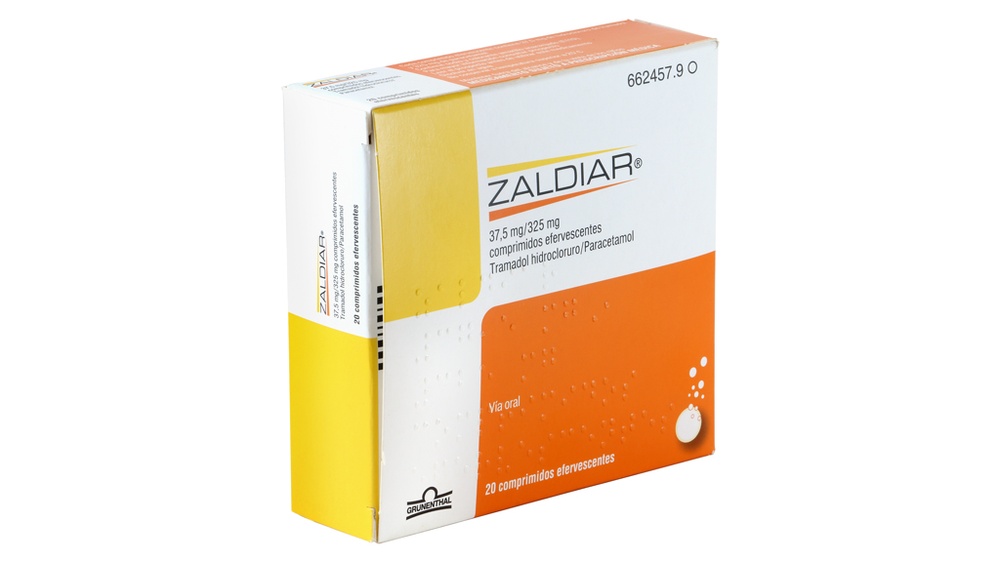

ZALDIAR 37.5 mg/325 mg EFFERVSCENT TABLETS

Ask a doctor about a prescription for ZALDIAR 37.5 mg/325 mg EFFERVSCENT TABLETS

How to use ZALDIAR 37.5 mg/325 mg EFFERVSCENT TABLETS
Introduction
Package Leaflet: Information for the User
Zaldiar 37.5 mg/325 mg Effervescent Tablets
Tramadol Hydrochloride/Paracetamol
Read all of this leaflet carefully before you start taking this medicine because it contains important information for you.
- Keep this leaflet, you may need to read it again.
- If you have any further questions, ask your doctor or pharmacist.
- This medicine has been prescribed for you only. Do not pass it on to others. It may harm them, even if their signs of illness are the same as yours.
- If you get any side effects, talk to your doctor or pharmacist. This includes any possible side effects not listed in this leaflet. See section 4.
Contents of the pack
- What Zaldiar is and what it is used for
- What you need to know before you take Zaldiar
- How to take Zaldiar
- Possible side effects
- Storage of Zaldiar
- Contents of the pack and other information
1. What Zaldiar is and what it is used for
Zaldiar is a combination of two painkillers, tramadol hydrochloride and paracetamol, which work together to relieve pain.
This medicine is used to treat moderate to severe pain when your doctor thinks that a combination of tramadol hydrochloride and paracetamol is needed.
This medicine should only be used by adults and adolescents over 12 years of age.
2. What you need to know before you take Zaldiar
Do not take Zaldiar
- if you are allergic to tramadol hydrochloride, paracetamol, orange yellow colour (E110) or any of the other ingredients of this medicine (listed in section 6);
- if you have taken any medicine for the treatment of depression, painkillers or psychotropic medicines (medicines that can alter mood and emotions) in case of acute alcohol intoxication;
- if you are taking, or have taken in the last 14 days, monoamine oxidase inhibitors (MAOIs) (certain medicines used for the treatment of depression or Parkinson's disease);
- if you have severe liver disease;
- if you have epilepsy that is not adequately controlled with your current treatment.
Warnings and precautions
Consult your doctor before taking Zaldiar if
- you are taking other medicines that contain paracetamol or tramadol hydrochloride;
- you have liver or kidney problems or if you notice that your eyes or skin turn yellow. This may be a sign of jaundice or problems with your bile ducts;
- you have kidney problems;
- you have severe breathing difficulties, for example, asthma or severe lung problems;
- you are epileptic or have had seizures or convulsions;
- you suffer from depression and are taking antidepressants, as some may interact with tramadol (see “Taking Zaldiar with other medicines”);
- you have recently had a head injury, shock, or severe headaches associated with vomiting;
- you are dependent on any other medicine used for pain relief, for example, morphine;
- you are taking other painkillers that contain buprenorphine, nalbuphine, or pentazocine;
- you are going to have an anaesthetic. Tell your doctor or dentist that you are taking this medicine.
Tolerance, dependence, and addiction
This medicine contains tramadol, which is an opioid medicine. Repeated use of opioids can make the medicine less effective (the body gets used to it, which is known as pharmacological tolerance). Repeated use of Zaldiar can also lead to dependence, abuse, and addiction, which could result in a potentially life-threatening overdose.
The risk of these side effects may be greater with higher doses and longer use.
Dependence or addiction can lead to a feeling of lack of control over the amount of medicine you need to use or how often you need to use it.
The risk of dependence or addiction varies from person to person. The risk of becoming dependent on or addicted to Zaldiar may be greater if:
- You or a family member have abused alcohol, prescription medicines, or illegal drugs (“addiction”).
- You are a smoker.
- You have had problems with your mood (depression, anxiety, or personality disorder) or have been treated by a psychiatrist for other mental health problems.
If you notice any of the following symptoms while taking Zaldiar, it could be a sign of dependence or addiction:
- You need to use the medicine for longer than your doctor told you.
- You need to use a higher dose than recommended.
- You are using the medicine for reasons other than those prescribed, for example, “to feel calm” or “to help you sleep”.
- You have made repeated unsuccessful attempts to stop using the medicine or control your use.
- You feel unwell when you stop using the medicine, and you feel better once you start taking it again (“withdrawal symptoms”).
If you notice any of these signs, consult your doctor to determine the best course of treatment for you, when it is appropriate to stop the medicine, and how to do so safely (see section 3, if you stop taking Zaldiar).
Sleep-related breathing disorders
This medicine contains an active substance that belongs to the group of opioids. Opioids can cause sleep-related breathing disorders, for example, central sleep apnea (shallow breathing or pauses in breathing during sleep) and sleep-related hypoxemia (low oxygen levels in the blood).
The risk of experiencing central sleep apnea depends on the dose of opioids. Your doctor may consider reducing the total dose of opioids if you experience central sleep apnea.
There is a weak risk that you may experience serotonin syndrome, which can occur after taking tramadol in combination with certain antidepressants or tramadol alone. Consult a doctor immediately if you experience any of the symptoms associated with this serious syndrome (see section 4 “Possible side effects”).
Tramadol is transformed in the liver by an enzyme. Some people have a variation of this enzyme, and this can affect each person differently. In some people, sufficient pain relief may not be achieved, while others may be more likely to experience serious side effects. If you notice any of the following side effects, you must stop taking this medicine and consult a doctor immediately: slow or shallow breathing, confusion, drowsiness, constricted pupils, general feeling of being unwell, or vomiting, constipation, loss of appetite.
If you have had any of these problems in the past while taking this medicine, please inform your doctor. He will decide whether you should continue taking this medicine.
Children and adolescents
Use in children with respiratory problems:
Tramadol is not recommended for use in children with respiratory problems, as the symptoms of tramadol toxicity can worsen in these children.
Tell your doctor if you experience any of the following symptoms while taking this medicine:
Extreme fatigue, loss of appetite, severe abdominal pain, nausea, vomiting, or low blood pressure. These may be signs of adrenal insufficiency (low cortisol levels). If you have these symptoms, contact your doctor, who will decide whether you need to take hormone supplements.
Taking Zaldiar with other medicines
Tell your doctor or pharmacist if you are taking, have recently taken, or might take any other medicines.
Important: This medicine contains paracetamol and tramadol hydrochloride. Tell your doctor if you are takingany other medicine that contains paracetamol or tramadol hydrochloride, so that you do not exceed the maximum daily dose.
This medicine must not be takenwith monoamine oxidase inhibitors (MAOIs) (see section “Do not take Zaldiar”).
It is not recommended to use this medicine if you are being treated with:
- Carbamazepine (a medicine normally used to treat epilepsy or certain types of pain, such as severe facial pain called trigeminal neuralgia).
- Buprenorphine, nalbuphine, or pentazocine (opioid painkillers). Pain relief may be reduced.
Tell your doctor or pharmacist if you are taking:
flucloxacillin (an antibiotic), due to a serious risk of alteration of blood and fluids (metabolic acidosis with high anion gap) that needs to be treated urgently and may occur particularly in case of severe kidney or liver failure, sepsis (when bacteria and their toxins circulate in the blood, leading to organ damage), malnutrition, chronic alcoholism, and if the maximum daily doses of paracetamol are used, especially if the maximum daily dose of paracetamol is used for a longer period. Metabolic acidosis with high anion gap is a serious disease that needs urgent treatment.
The risk of side effects increases if you are taking:
- triptans (for the treatment of migraine) or selective serotonin reuptake inhibitors, “SSRIs” (for the treatment of depression). If you experience confusion, agitation, fever, sweating, uncoordinated movements of the limbs or eyes, muscle contractions, or diarrhea, you should call your doctor.
- other painkillers such as morphine and codeine (also when used for the treatment of cough), baclofen (a muscle relaxant), certain medicines to lower blood pressure, medicines for the treatment of allergies. You may feel drowsy or dizzy. If this happens, consult your doctor.
Taking this medicine with sedative medicines such as benzodiazepines or related medicines increases the risk of drowsiness, breathing difficulties (respiratory depression), coma, and can be potentially life-threatening. For this reason, concomitant use should only be considered when no other treatment options are possible. However, if your doctor prescribes this medicine with sedative medicines, you should limit the dose and duration of concomitant treatment.
Tell your doctor about all sedative medicines you are taking and follow your doctor's dose recommendation strictly. It may be useful to inform your friends and family about the signs and symptoms mentioned above. Tell your doctor if you experience any of these symptoms.
- medicines that can cause seizures, such as certain antidepressants or antipsychotics. The risk of seizures increases if you take this medicine at the same time as these medicines. Your doctor will tell you if this medicine is suitable for you.
- medicines for the treatment of depression. This medicine can interact with these medicines, and you may experience serotonin syndrome (see section 4 “Possible side effects”).
- warfarin or phenprocoumon (a medicine used to prevent blood clots). The effectiveness of these medicines may be altered, and there is a risk of bleeding. You should inform your doctor immediately of any prolonged or unexpected bleeding.
- gabapentin or pregabalin for the treatment of epilepsy or pain due to nerve problems (neuropathic pain).
The effectiveness of this medicine may be altered if you also take:
- metoclopramide, domperidone, or ondansetron (medicines for the treatment of nausea and vomiting),
- cholestyramine (a medicine that lowers cholesterol in the blood).
Your doctor will know which medicines are safe to use with this medicine.
Taking Zaldiar with food and alcohol
This medicine can make you feel drowsy. Alcohol can make you feel drowsy, so it is recommended not to drink alcohol while taking this medicine.
Pregnancy, breastfeeding, and fertility
If you are pregnant or breastfeeding, think you may be pregnant, or are planning to have a baby, ask your doctor or pharmacist for advice before taking this medicine.
Because this medicine contains tramadol hydrochloride, it is not recommended to take this medicine during pregnancy or breastfeeding. If you become pregnant during treatment with this medicine, consult your doctor before taking the next tablet.
Breastfeeding
Tramadol is excreted in breast milk. For this reason, you should not take this medicine more than once during breastfeeding, or if you take this medicine more than once, you should stop breastfeeding.
Based on human experience, tramadol is not expected to affect fertility in men and women. There are no data available on the combination of tramadol and paracetamol on fertility.
Driving and using machines
Ask your doctor if you can drive or use machines while taking this medicine. It is important that before driving or using machines, you see how this medicine affects you. Do not drive or use machines if you feel drowsy, dizzy, have blurred vision, or double vision, or have difficulty concentrating. Be particularly careful at the start of treatment, after a dose increase, after a change in formulation, and/or when taking it with other medicines.
Zaldiar contains orange yellow colour (E110), sodium, and sulfite
This medicine can cause allergic reactions because it contains orange yellow colour (E110). It can cause asthma, especially in patients allergic to acetylsalicylic acid.
This medicine contains 179.3 mg of sodium (a major component of cooking/table salt) in each effervescent tablet. This is equivalent to 9.0% of the maximum recommended daily dietary intake of sodium for an adult. Consult your doctor or pharmacist if you need to take 2 or more effervescent tablets daily for a prolonged period, especially if you have been advised to follow a low-salt diet (sodium).
The orange flavouring of this medicine contains small amounts of sulfite, which can rarely cause severe hypersensitivity reactions and bronchospasm.
3. How to take Zaldiar
Follow exactly the administration instructions of this medicine given by your doctor. If you are unsure, consult your doctor or pharmacist again.
Before starting treatment and regularly during treatment, your doctor will also explain what you can expect from the use of Zaldiar, when and for how long you should use it, when you should contact your doctor, and when you should stop using it (see also section 2).
You should take this medicine for the shortest possible time.
This medicine is not recommended for use in children under 12 years of age.
The dose should be adjusted according to the intensity of the pain and your individual sensitivity. Normally, the lowest possible dose that provides pain relief should be used.
Unless your doctor has prescribed otherwise, the recommended starting dose for adults and adolescents over 12 years of age is 2 effervescent tablets.
If necessary, you can increase the dose, as recommended by your doctor. The shortest interval between doses must be at least 6 hours.
Do not take more than 8 effervescent tabletsper day.
Do not take this medicine more frequently than your doctor has told you.
Elderly patients
In elderly patients (over 75 years of age), the elimination of tramadol may be slow. If this applies to you, your doctor may recommend prolonging the dosing intervals.
Patients with liver or kidney impairment/patients on dialysis
If you have severe liver or kidney disease, treatment with this medicine is not recommended. If you have moderate liver or kidney impairment, your doctor may prolong the dosing intervals.
Method of administration
The effervescent tablets are taken orally.
The effervescent tablets are taken dissolved in a glass of water.
If you think that the effect of this medicine is too strong (e.g., you feel very drowsy or have difficulty breathing) or too weak (e.g., you do not have adequate pain relief), tell your doctor.
If you take more Zaldiar than you should
If you have taken more of this medicine than you should, even if you feel well, contact your doctor or pharmacist immediately, as there is a risk of serious liver damage that may only become apparent later.
In case of overdose or accidental ingestion, contact the Toxicology Information Service, telephone 91 562 04 20, indicating the medicine and the amount taken.
If you forget to take Zaldiar
If you forget to take a dose of this medicine, it is likely that the pain will return. Do not take a double dose to make up for the forgotten doses, simply continue taking the effervescent tablets as usual.
If you stop taking Zaldiar
Do not stop taking this medicine suddenly unless your doctor tells you to. If you want to stop taking your medicine, talk to your doctor first, especially if you have been taking it for a long time. Your doctor will tell you when and how to stop taking it, which can be done by gradually reducing the dose to reduce the likelihood of unnecessary side effects (withdrawal symptoms).
If you have any further questions on the use of this medicine, ask your doctor or pharmacist.
4. Possible Adverse Effects
Like all medicines, this medicine can cause adverse effects, although not all people suffer from them.
Very frequent: may affect more than 1 in 10 people;
- nausea,
- dizziness, drowsiness.
Frequent: may affect 1 in 10 people;
- vomiting, digestive problems (constipation, flatulence, diarrhea), stomach pain, dry mouth,
- itching, increased sweating (hyperhidrosis),
- headache, agitation,
- confusion, sleep disorders, mood changes (anxiety, nervousness, euphoria - feeling of being "high-spirited" all the time).
Infrequent: may affect 1 in 100 people;
- increased heart rate or increased blood pressure, cardiac rhythm and frequency disorders,
- tingling sensation, numbness or sensation of pins and needles in the limbs, ringing in the ears, involuntary muscle spasms,
- depression, nightmares, hallucinations (hearing, seeing or perceiving something that does not exist in reality), memory loss,
- difficulty breathing,
- difficulty swallowing, blood in the stool,
- skin reactions (e.g. rashes, urticarial edema),
- increased liver enzyme values,
- presence of albumin in the urine, difficulty or pain when urinating,
- chills, hot flashes, chest pain.
Rare: may affect 1 in 1,000 people;
- seizures, difficulties in carrying out coordinated movements, transient loss of consciousness (syncope),
- dependence on the medicine,
- delirium,
- blurred vision, pupil constriction (miosis),
- speech disorders,
- excessive dilation of the pupils (mydriasis).
Frequency not known:
- decrease in blood sugar levels (hypoglycemia),
- serotonin syndrome, which can manifest through changes in mental state (e.g. agitation, hallucinations, coma), and other effects, such as fever, increased heart rate, unstable blood pressure, involuntary muscle contractions, muscle stiffness, lack of coordination and/or gastrointestinal symptoms (e.g. nausea, vomiting, diarrhea) (see section 2 "What you need to know before taking Zaldiar").
The following recognized adverse effects have been reported by people who have taken medicines that contained only tramadol hydrochloride or only paracetamol. However, if you experience any of these symptoms while taking this medicine, you should tell your doctor:
- Feeling of dizziness when standing up after lying down or sitting, low heart rate, fainting, changes in appetite, muscle weakness, slower or weaker breathing, changes in mood, changes in activity, changes in perception, worsening of asthma.
- Taking this medicine with anticoagulants (e.g. phenprocoumon, warfarin) may increase the risk of bleeding. You should inform your doctor immediately about any prolonged or unexpected bleeding.
- Taking paracetamol alone or when taken with the antibiotic flucloxacillin may induce an anomaly in the blood and fluids (metabolic acidosis with high anion gap) when there is an increase in blood plasma acidity.
- In rare cases, skin rashes, indicating allergic reactions that can manifest through sudden swelling of the face and neck, shortness of breath or drop in blood pressure and dizziness. If this happens, stop treatment and consult your doctor immediately. You should not take this medicine again.
In rare cases, using a medicine like tramadol hydrochloride can create dependence, making it difficult to stop taking it.
In rare cases, people who have been taking tramadol hydrochloride for some time may feel unwell if they suddenly stop treatment. They may feel agitated, anxious, nervous or trembly. They may be hyperactive, have difficulty sleeping and have digestive and intestinal disorders. Very few people may also have panic attacks, hallucinations, unusual perceptions such as itching, tingling and numbness, and ringing in the ears (tinnitus). If you experience any of these symptoms after stopping treatment with this medicine, please consult your doctor.
Frequency not known: hiccups.
In exceptional cases, blood tests may reveal certain anomalies, such as low platelet count, which can result in nosebleeds or bleeding gums.
In very rare cases, serious skin reactions have been reported with paracetamol.
Rare cases of respiratory depression have been reported with tramadol.
Reporting of Adverse Effects:
If you experience any type of adverse effect, consult your doctor or pharmacist, even if it is a possible adverse effect that is not listed in this prospectus. You can also report them directly through the Spanish Pharmacovigilance System for Human Use Medicines: https://www.notificaram.es. By reporting adverse effects, you can contribute to providing more information on the safety of this medicine.
5. Conservation of Zaldiar
Keep this medicine out of sight and reach of children.
Store this medicine in a safe and protected place, where others cannot access it. This medicine can cause serious harm and even be fatal to people who have not been prescribed it.
Do not use this medicine after the expiration date that appears on the box and on the aluminum strip after CAD. The expiration date is the last day of the month indicated.
Do not store at a temperature above 25°C.
Medicines should not be thrown away through wastewater or household waste. Deposit the containers and medicines you no longer need at the SIGRE Point in the pharmacy. In case of doubt, ask your pharmacist how to dispose of the containers and medicines you no longer need. This way, you will help protect the environment.
6. Package Contents and Additional Information
Zaldiar Composition
- The active ingredients are tramadol hydrochloride and paracetamol.
Each effervescent tablet contains 37.5 mg of tramadol hydrochloride and 325 mg of paracetamol.
- The other components (excipients) are:
Anhydrous monosodium citrate, anhydrous citric acid, Povidone K30, sodium hydrogencarbonate, Macrogol 6000, anhydrous colloidal silica, magnesium stearate, orange flavor (contains maltodextrin from corn, modified starch (E1450), natural and artificial flavors, sulfite), acesulfame potassium, sodium saccharin, yellow-orange colorant (E110).
Appearance of Zaldiar and Package Contents
White to slightly pink tablets with colored speckles. The tablets are packaged in coated aluminum strips.
It is available in boxes of 2, 10, 20, 30, 40, 50, 60, 70, 80, 90 or 100 effervescent tablets.
Only some package sizes may be marketed.
Marketing Authorization Holder
Grünenthal Pharma, S.A.
Doctor Zamenhof, 36 – 28027 Madrid, Spain
Manufacturer
Grünenthal GmbH
Zieglerstrasse 6 – D-52078 Aachen, Germany
This medicine is authorized in the Member States of the European Economic Area and in the United Kingdom (Northern Ireland) with the following names:
Slovenia Zaldiar® 37,5 mg/325 mg šumece tablete
Spain Zaldiar® 37,5 mg/325 mg effervescent tablets
France Ixprim® 37,5mg/325mg, comprimé effervescent Zaldiar® 37,5mg/325mg, comprimé effervescent
Hungary Zaldiar® 37.5 mg/325 mg, pezsgotabletta
Ireland Ixprim® effervescent 37.5 mg/325 mg, effervescent tablet
Portugal Zaldiar® EFE 37,5mg/325 mg effervescent tablets
United Kingdom (Northern Ireland) Tramacet® 37.5 mg/325 mg effervescent tablet
Date of the last revision of this prospectus: December 2024
Detailed and updated information on this medicine is available on the website of the Spanish Agency for Medicines and Health Products (AEMPS) http://www.aemps.gob.es/


How much does ZALDIAR 37.5 mg/325 mg EFFERVSCENT TABLETS cost in Spain ( 2025)?
The average price of ZALDIAR 37.5 mg/325 mg EFFERVSCENT TABLETS in December, 2025 is around 2.97 EUR. Prices may vary depending on the region, pharmacy, and whether a prescription is required. Always check with a local pharmacy or online source for the most accurate information.
- Country of registration
- Average pharmacy price2.97 EUR
- Active substance
- Prescription requiredYes
- Manufacturer
- This information is for reference only and does not constitute medical advice. Always consult a licensed doctor before taking any medication. Oladoctor is not responsible for medical decisions based on this content.
- Alternatives to ZALDIAR 37.5 mg/325 mg EFFERVSCENT TABLETSDosage form: TABLET, 325/37.5 mgActive substance: tramadol and paracetamolManufacturer: Ferrer Internacional S.A.Prescription requiredDosage form: TABLET, 650/75 mgActive substance: tramadol and paracetamolManufacturer: Ferrer Internacional S.A.Prescription requiredDosage form: EFFERVESCENT TABLET, 37.5 mg/325 mgActive substance: tramadol and paracetamolManufacturer: Aristo Pharma Iberia S.L.Prescription required
Alternatives to ZALDIAR 37.5 mg/325 mg EFFERVSCENT TABLETS in other countries
The best alternatives with the same active ingredient and therapeutic effect.
Alternative to ZALDIAR 37.5 mg/325 mg EFFERVSCENT TABLETS in Poland
Online doctors for ZALDIAR 37.5 mg/325 mg EFFERVSCENT TABLETS
Discuss dosage, side effects, interactions, contraindications, and prescription renewal for ZALDIAR 37.5 mg/325 mg EFFERVSCENT TABLETS – subject to medical assessment and local rules.














